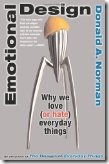 I have long been a fan of user interface design and design in general. Having been impressed by The Design of Everyday Things, I decided to pick up a few more of Donald A. Norman’s books. Emotional Design, why we love (or hate) Everyday Things, is about how the design of things effect us emotionally. Or more accurately how we can design things to elicit the emotional response that marketers want.
I have long been a fan of user interface design and design in general. Having been impressed by The Design of Everyday Things, I decided to pick up a few more of Donald A. Norman’s books. Emotional Design, why we love (or hate) Everyday Things, is about how the design of things effect us emotionally. Or more accurately how we can design things to elicit the emotional response that marketers want.
Although Dr. Norman tends to have a rather dry academic writing style from time to time, he backs up his claims with many stories and examples. Overall I found this book to be very interesting and I picked up some very interesting tidbits on how design effects us on many levels. The book primarily focuses on the design of physical things rather than software specifically but many of the principals can be applied to software as well.
One of the very interesting studies presented in this book showed that attractive things work better. It brought to mind the “form follows function” premise from architecture. In the study by Noam Tractinsky ATMs were compared. All of the ATMs performed the same functions, had the same number of buttons but some were more attractive. In all of the tests users felt that the more attractive ATMs worked better than the less attractive ones.
This demonstrates how the look and feel of a device is just as important as the function of the actual device. Take the iPhone, which revolutionized the smart phone industry, its functionality isn’t completely revolutionary but its look and feel was entirely new. Smart phones have allowed for phone calls, web surfing, games and many other applications for many years but none of them did it in such an elegant way. The clean interface and simple yet sophisticated design of the iPhone made it a winner in the smart phone market.
Dr. Norman describes our reaction to the design of things into three levels; visceral, behavioral and reflective. We process the things we see and use first on a visceral level, how it looks and feels. We then explore how the item behaves or does what it was designed to do. Then we reflect on our past experiences with the item.
The book builds upon these three principals of design with many examples and stories. There is a very interesting discussion about emotional machines, think the Turing Test. This translates into the future of robots as well, think of your favorite movie robot. The design of robots that are truly useful will have many human characteristics to make interacting with them more natural.
The bottom line: This book provides a good perspective on how our designs affect the users. By providing a functional device or application that is also appealing on a variety of levels we will be more successful. I always love to hear from our customers about how easy our software is to use and how great their experience was with our products.



No comments:
Post a Comment